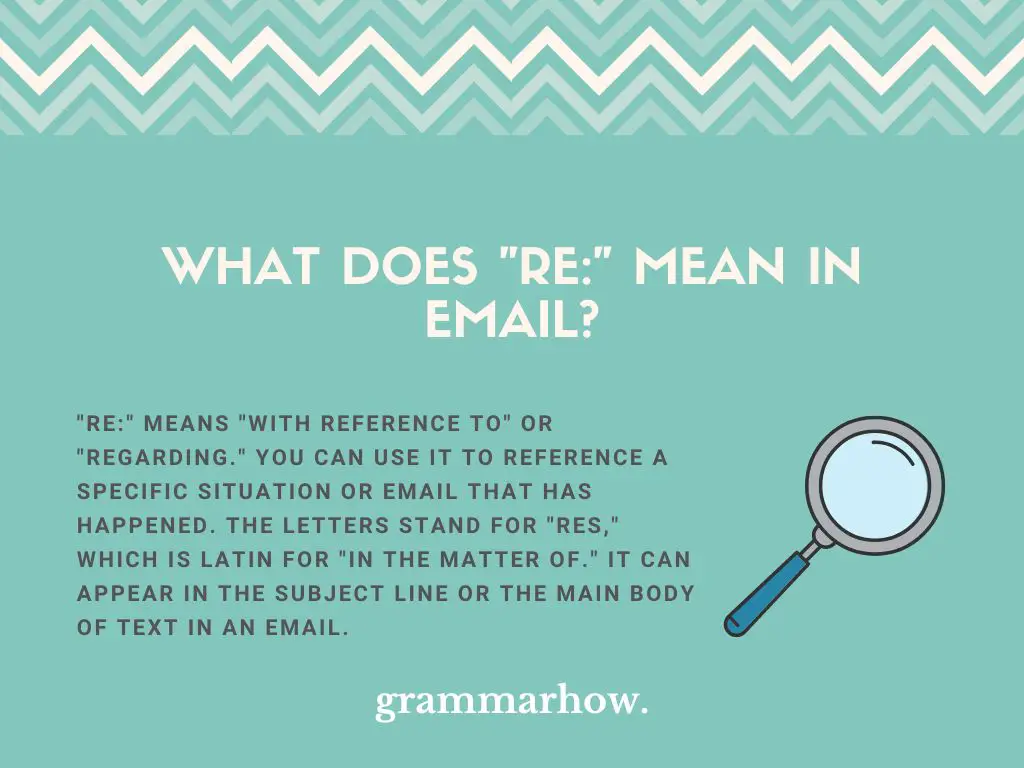“Re:” appears in email subject lines all the time. It would be useful to know what it means and how to use it correctly. This article will explain all you need to know about including “Re:” in the subject line of your emails.
What Does “Re:” Mean in Email?
“Re:” means “with reference to” or “regarding.” You can use it to reference a specific situation or email that has happened. The letters stand for “res,” which is Latin for “in the matter of.” It can appear in the subject line or the main body of text in an email.

There are two ways you can use “Re:” in an email. The first is in the subject line. This allows you to respond to a specific subject or email that has already been sent to you.
For example, if someone sent you an email entitled:
- The Changes
You could reply to the email with the subject line:
- Re: The Changes
Alternatively, you could include “re:” in the text body of your email. This will allow you to reference a specific subject within the email. You can include mid-sentence, like this:
- I am writing re: the problems we had.
How to Use “Re:” in Email
It would help to know more about “Re”: in practice before using it yourself.
You can reply to an email with “Re:” in the subject line. This indicates that you have something specific to reference relating to a previous email you received. It makes it clear to the recipient that you are replying to their previous message.
Here are some examples to show you how it appears in the subject line:
- Re: The New Rules
- Dear sir,
- I would appreciate any information you can give about the new rules.
- All the best,
- Jon
- RE: Damage Control
- Dear Mr. Smith,
- I think we need to control what happens next before things get out to the public.
- Kind regards,
- Danny
It’s possible to include “re:” in the text body of your email too. You should do this when you want to reference a specific subject without having referenced it already.
For example, if you are initiating an email with someone, you wouldn’t have anything to reply to. Therefore, you should include “Re:” in the email body rather than the subject line to show that there’s something you want to raise with the recipient.
You could also use it in an email body, like this:
- Dear Mr. Parker,
- I’m having a difficult time re: the issues you presented to me the other day. Can you help me?
- All the best,
- Chrissy
- Dear Howard,
- I’m writing this email re: the new changes to the staff rota. I’m not sure I appreciate the new system.
- Kind regards,
- Jenkins
When Should I Use “Re:” in Emails?
You should use “Re:” when you want to reply to an email or reference something that’s happened before.
“Re:” is often an automatic inclusion in an email subject line when you press “Reply.” It allows you to reply to the email you received. This gives people an idea of what to expect from your email without having to read it straight away.
You should also use it when you have specific grievances or issues to raise with someone. You can use “re:” to reference those issues to make them known to the recipient.
When Should I Avoid Using “Re:” in Emails?
“Re:” is often automatic, meaning you don’t have to avoid using it in many formal cases. If you click “Reply” to an email, “Re:” will appear even if you don’t want it to.
You may want to remove “Re:” if you do not feel like the email you’re sending is related to the email you’re replying to. There are no rules about keeping or removing “Re:” from the subject line, so you do not have to avoid using it there.
Including “re:” in the email body isn’t always the best option. Sometimes, it’s best to write “with reference to” or “referring to.” These phrases help to keep the body of your email more formal.
Final Thoughts
“Re:” is commonly seen in emails when you want to reply to something someone sent you. It’s also common to use when referencing something that has happened previously. It’s an abbreviation of “with reference to” that comes from the Latin word “res” (“in the matter of”).

Martin holds a Master’s degree in Finance and International Business. He has six years of experience in professional communication with clients, executives, and colleagues. Furthermore, he has teaching experience from Aarhus University. Martin has been featured as an expert in communication and teaching on Forbes and Shopify. Read more about Martin here.
